Recent Ground Subsidence in the North China Plain, China, Revealed by Sentinel-1A Datasets
Abstract
1. Introduction
2. Study Area
3. SAR Data and MT-InSAR Processing
4. Results
4.1. Land Subsidence in the NCP during the Observation Period
4.2. Validation
5. Discussion
5.1. Comparison with Groundwater Levels
5.2. Comparison with Land Use
5.3. Other Factors
6. Conclusions
Supplementary Materials
Author Contributions
Funding
Acknowledgments
Conflicts of Interest
References
- Fei, Y.; Zhang, Z.; Zhang, F.; Wang, Z.; Chen, Z.; Chen, J.; Qian, Y.; Li, Y. An analysis of the influence of human activity and climate change on water resources of the North China Plain. ACTA Geosci. SNICA 2007, 28, 567–571. [Google Scholar]
- Wu, Y. Mechanism analysis of hazards caused by the interaction between groundwater and geoenvironment. Environ. Geol. 2003, 44, 811–819. [Google Scholar] [CrossRef]
- Tomás, R.; Márquez, Y.; Lopez-Sanchez, J.M.; Delgado, J.; Blanco, P.; Mallorquí, J.J.; Martínez, M.; Herrera, G.; Mulas, J. Mapping ground subsidence induced by aquifer overexploitation using advanced Differential SAR Interferometry: Vega Media of the Segura River (SE Spain) case study. Remote Sens. Environ. 2005, 98, 269–283. [Google Scholar] [CrossRef]
- Chaussard, E.; Wdowinski, S.; Cabral-Cano, E.; Amelung, F. Land subsidence in central Mexico detected by ALOS InSAR time-series. Remote Sens. Environ. 2014, 140, 94–106. [Google Scholar] [CrossRef]
- Caló, F.; Notti, D.; Galve, J.P.; Abdikan, S.; Görüm, T.; Pepe, A.; Şanli, F.B. DInSAR-based detection of land subsidence and correlation with groundwater depletion in konya plain, Turkey. Remote Sens. 2017, 9, 83. [Google Scholar] [CrossRef]
- Haghshenas, M.; Motagh, M. Ground surface response to continuous compaction of aquifer system in Tehran, Iran: Results from a long-term multi-sensor InSAR analysis. Remote Sens. Environ. 2019, 221, 534–550. [Google Scholar] [CrossRef]
- Gee, D.; Sowter, A.; Grebby, S.; De Lange, G.; Athab, A.; Marsh, S.; Ng, N.; Kingdom, U. National geohazards mapping in Europe: Interferometric analysis of the Netherlands. Eng. Geol. 2019, 256, 1–22. [Google Scholar] [CrossRef]
- Del Soldato, M.; Farolfi, G.; Rosi, A.; Raspini, F.; Casagli, N. Subsidence evolution of the Firenze-Prato-Pistoia plain (Central Italy) combining PSI and GNSS data. Remote Sens. 2018, 10, 1146. [Google Scholar] [CrossRef]
- Mateos, R.M.; Ezquerro, P.; Luque-Espinar, J.A.; Béjar-Pizarro, M.; Notti, D.; Azañón, J.M.; Montserrat, O.; Herrera, G.; Fernández-Chacón, F.; Peinado, T.; et al. Multiband PSInSAR and long-period monitoring of land subsidence in a strategic detrital aquifer (Vega de Granada, SE Spain): An approach to support management decisions. J. Hydrol. 2017, 553, 71–87. [Google Scholar] [CrossRef]
- Ruiz-Constan, A.; Ruiz-Armenteros, A.M.; Martos-Rosillo, S.; Galindo-Zaldivar, J.; Lazecky, M.; Garcia, M.; Sousa, J.J.; Sanz de Galdeano, C.; Delgado-Blasco, J.M.; Jimenez-Gavilan, P.; et al. SAR interferometry monitoring of subsidence in a detritic basin related to water depletion in the underlying confined carbonate aquifer (Torremolinos, southern Spain). Sci. Total. Env. 2018, 636, 670–687. [Google Scholar] [CrossRef]
- Asselen, S.V.; Erkens, G.; Stouthamer, E.; Woolderink, H.A.G.; Geeraert, R.E.E.; Hefting, M.M. The relative contribution of peat compaction and oxidation to subsidence in built-up areas in the Rhine-Meuse delta, The Netherlands. Sci. Total. Environ. 2018, 636, 177–191. [Google Scholar] [CrossRef]
- Del, M.; Tomás, R.; Pont, J.; Herrera, G. A multi-sensor approach for monitoring a road bridge in the Valencia harbor (SE Spain) by SAR Interferometry (InSAR). Rend. Online Soc. Geol. It. 2016, 41, 235–238. [Google Scholar] [CrossRef]
- Dai, K.; Liu, G.; Li, Z.; Ma, D.; Wang, X.; Zhang, B.; Tang, J.; Li, G. Monitoring highway stability in permafrost regions with X-band temporary scatterers stacking InSAR. Sensors 2018, 18, 1876. [Google Scholar] [CrossRef] [PubMed]
- Wang, H.; Chang, L.; Markine, V. Structural health monitoring of raliway transition zones using satellite radar data. Sensors 2018, 18, 413. [Google Scholar] [CrossRef]
- Ezquerro, P.; Del Soldato, M.; Solari, L.; Tom, R.; Raspini, F.; Ceccatelli, M.; Fern, A.; Casagli, N.; Herrera, G. Vulnerability Assessment of Buildings due to Land Subsidence Using InSAR Data in the Ancient Historical City of Pistoia (Italy). Sensors 2020, 20, 2749. [Google Scholar] [CrossRef] [PubMed]
- Chen, W.; Gong, H.; Chen, B.; Liu, K.; Gao, M.; Zhou, C. Spatiotemporal evolution of land subsidence around a subway using InSAR time-series and the entropy method. GIScience Remote Sens. 2017, 54, 78–94. [Google Scholar] [CrossRef]
- Yang, Q.; Ke, Y.; Zhang, D.; Chen, B.; Gong, H.; Lv, M.; Zhu, L.; Li, X. Multi-scale analysis of the relationship between land subsidence and buildings: A case study in an eastern Beijing Urban Area using the PS-InSAR technique. Remote Sens. 2018, 10, 1006. [Google Scholar] [CrossRef]
- Zhou, C.; Gong, H.; Chen, B.; Li, X.; Li, J.; Wang, X.; Gao, M.; Si, Y.; Guo, L.; Shi, M.; et al. Quantifying the contribution of multiple factors to land subsidence in the Beijing Plain, China with machine learning technology. Geomorphology 2019, 335, 48–61. [Google Scholar] [CrossRef]
- Zhang, J.; Chu, L.; Xiao, Z.; Lu, Z.; Shen, R.; Chen, Y. Main progress and achievements of land subsidence survey and monitoring in Hebei Plain. Geol. Surv. CHINA 2014, 1, 45–50. [Google Scholar]
- Lyu, M.; Ke, Y.; Li, X.; Zhu, L.; Guo, L. Detection of seasonal deformation of highway overpasses using the PS-InSAR technique: A case study in Beijing urban area. Remote Sens. 2020, 18, 3071. [Google Scholar] [CrossRef]
- Liu, M.; Jia, S.; Chu, H. The monitoring system and technologies of land subsidence in Beijing. Geol. Resour. 2012, 21. [Google Scholar] [CrossRef]
- Lyu, X.; Song, L.; Shao, X.; Li, J. The suggestion and application of land subsidence monitoring in Tianjin. Shanghai L. Resour. 2017, 38, 26–30. [Google Scholar]
- Ferretti, A.; Prati, C.; Rocca, F. Nonlinear subsidence rate estimation using permanent scatterers in differential SAR interferometry. IEEE Trans. Geosci. Remote Sens. 2000, 38, 2202–2212. [Google Scholar] [CrossRef]
- Ferretti, A.; Prati, C.; Rocca, F. Permanent scatterers InSAR interferometry. IEEE Trans. Geosci. Remote Sens. 2000, 39, 8–20. [Google Scholar] [CrossRef]
- Berardino, P.; Fornaro, G.; Lanari, R.; Member, S.; Sansosti, E.; Member, S. A new algorithm for surface deformation monitoring based on Small Baseline differential SAR interferograms. IEEE Trans. Geosci. Remote Sens. 2002, 40, 2375–2383. [Google Scholar] [CrossRef]
- Luo, Q.; Perissin, D.; Zhang, Y.; Jia, Y. L- and X-Band multi-temporal InSAR analysis of Tianjin subsidence. Remote Sens. 2014, 6, 7933–7951. [Google Scholar] [CrossRef]
- Liu, P.; Li, Q.; Li, Z.; Hoey, T.; Liu, G.; Wang, C.; Hu, Z.; Zhou, Z.; Singleton, A. Anatomy of subsidence in Tianjin from time series InSAR. Remote Sens. 2016, 8, 266. [Google Scholar] [CrossRef]
- Zhou, H.; Wang, Y.; Yan, S.; Wu, Y.; Liu, Q. Land subsidence monitoring and analyzing of Cangzhou area Sentinel-1A/B based time series InSAR. Bull Surv. Map. 2017, 7, 89–93. [Google Scholar]
- Bai, Z.; Jin, G.; Zhang, H.; Xu, Q.; Hu, J.; Wang, B. Subsidence monitoring of Tianjin using PSInSAR technique with Sentinel-1A. J. Geomat. Sci. Technol. 2017, 34, 283–288. [Google Scholar]
- Lyu, M.; Ke, Y.; Guo, L.; Li, X.; Zhu, L.; Gong, H. Change in regional land subsidence in Beijing after south-to-north water diversion project observed using satellite radar interferometry. GIScience Remote Sens. 2019, 41, 140–156. [Google Scholar] [CrossRef]
- Zhang, T.; Shen, W.; Wu, W.; Zhang, B.; Pan, Y. Recent Surface Deformation in the Tianjin Area Revealed by Sentinel-1A Data. Remote Sens. 2019, 11, 130. [Google Scholar] [CrossRef]
- Zuo, J.; Gong, H.; Chen, B.; Liu, K.; Zhou, C.; Ke, Y. Time-Series Evolution Patterns of Land Subsidence in the Eastern Beijing Plain, China. Remote Sens. 2019, 11, 539. [Google Scholar] [CrossRef]
- Zhou, C.; Lan, H.; Gong, H.; Zhang, Y.; Timothy, A.; Clague, J.; Wu, Y. Reduced rate of land subsidence since 2016 in Beijing, China: Evidence from Tomo-PSInSAR using RadarSAT-2 and Sentinel-1 datasets. Int. J. Remote Sens. 2020, 41, 1259–1285. [Google Scholar] [CrossRef]
- Chen, Z.; Qi, J.; Xu, J.; Xu, J.; Ye, H.; Nan, Y. Paleoclimatic interpretation of the past 30 ka from isotopic studies of the deep confined aquifer of the North China plain. Appl Geochem. 2003, 18, 997–1009. [Google Scholar] [CrossRef]
- Chen, Z.; Nie, Z.; Zhang, Z.; Qi, J.; Nan, Y. Isotopes and sustainability of groundwater resources, North China Plain. Groundwater 2005, 43, 485–493. [Google Scholar] [CrossRef]
- Xue, X.; Li, J.; Xie, X.; Qian, K.; Wang, Y. Impacts of sediment compaction on iodine enrichment in deep aquifers of the North China Plain. Water Res. 2019, 159, 480–489. [Google Scholar] [CrossRef]
- Guo, H.; Zhang, Z.; Cheng, G.; Li, W.; Li, T.; Jiao, J. Groundwater-derived land subsidence in the North China Plain. Environ. Earth Sci. 2015, 74, 1415–1427. [Google Scholar] [CrossRef]
- Xing, L.; Guo, H.; Zhan, Y. Groundwater hydrochemical characteristics and processes along flow paths in the North China Plain. J. Asian Earth Sci. 2013, 70–71, 250–264. [Google Scholar] [CrossRef]
- Zhang, Z.; Shen, Z.; Xue, Y.; Ren, F.; Shi, D.; Yin, Z.; Zhong, Z.; Sun, X. Groundwater Environment Evolution in the North China Plain; Geological Publishing House: Beijing, China, 2000. [Google Scholar]
- Yang, Y. Land subsidence disaster prevention and cure in Beijing-Tianjin-Hebei area, China. Urban Geol. 2015, 10, 1–7. [Google Scholar]
- China Geological Survey. Atlas of Resources and Environment Geology in Beijing-Tianjin-Hebei Region 2015. Available online: https://www.cgs.gov.cn (accessed on 15 January 2020). (In Chinese)
- Guo, L.; Bo, W.; Yang, G. Characteristics of current deformation of fault belts in North China. J. Geod. Geodyn. 2003, 23, 29–36. [Google Scholar]
- Yao, Y. Analysis of crustal movement characteristics in the China mainland by high precision repeated measurements of GPS network. Prog. Geophys. 2008, 23, 1030–1037. [Google Scholar]
- Zhang, Y.; Wu, H.; Kang, Y.; Zhu, C. Ground Subsidence in the Beijing-Tianjin-Hebei Region from 1992 to 2014 Revealed by Multiple. Remote Sens. 2016, 1–17. [Google Scholar] [CrossRef]
- Fei, Y.; Miao, J.; Zhang, Z.; Chen, Z.; Song, H.; Yang, M. Analysis on evolution of groundwater depression cones and its leading factors in North China Plain. Resour. Sci. 2009, 31, 394–399. [Google Scholar] [CrossRef]
- Zhao, Q.; Zhang, B.; Yao, Y.; Wu, W.; Meng, G.; Chen, Q. Geodetic and hydrological measurements reveal the recent acceleration of groundwater depletion in North China Plain. J. Hydrol. 2019, 575, 1065–1072. [Google Scholar] [CrossRef]
- Gallyoway, D.L.; Hudnut, K.W.; Ingebritsen, S.E.; Phillips, S.P.; Peltzer, G.; Rosen, P.A. Detection of aquifer system compaction and land subsidence using interferometric synthetic aperture radar, Antelope Valley, Mojave Desert, California. Water Resour. Res. 1998, 34, 2573–2585. [Google Scholar] [CrossRef]
- Hoffmann, J.; Zebker, H.A.; Galloway, D.L. Seasonal subsidence and rebound in Las Vegas Valley, Nevada, observed by synthetic aperture radar interferometry. Water Resour. Res. 2001, 37, 1551–1566. [Google Scholar] [CrossRef]
- Zhu, J.; Guo, H.; Li, W.; Tian, X. Relationship between land subsidence and deep groundwater yield in the North China Plain. South-to-North Water Transf. Water Sci. Technol. 2014, 12, 165–169. [Google Scholar] [CrossRef]
- Chen, X.; Thorp, K.; Ouyang, Z.; Hou, Y.; Zhou, B.; Li, Y. Energy consumption due to groundwater pumping for irrigation in the North China Plain. Sci. Total. Environ. 2019, 669, 1033–1042. [Google Scholar] [CrossRef]
- Li, P.; Ren, L. Evaluating the effects of limited irrigation on crop water productivity and reducing deep groundwater exploitation in the North China Plain using an agro-hydrological model: II. Scenario simulation and analysis. J. Hydrol. 2019, 574, 715–732. [Google Scholar] [CrossRef]
- Russo, T.A.; Lall, U. Depletion and response of deep groundwater to climate-induced pumping variability. Nat. Geosci. 2017, 10, 105–108. [Google Scholar] [CrossRef]
- Li, P.; Ren, L. Evaluating the effects of limited irrigation on crop water productivity and reducing deep groundwater exploitation in the North China Plain using an agro-hydrological model: I. Parameter sensitivity analysis, calibration and model validation. J. Hydrol. 2019, 574, 497–516. [Google Scholar] [CrossRef]
- Wang, J.; Zhang, Y.; Wen, J.; Sun, J. Temporal and Spatial Changing Features of Climate in North China Plain. Geoscience 2015, 29, 299–306. [Google Scholar] [CrossRef]
- Meng, S.; Fei, Y.; Zhang, Z.; Lei, T.; Qian, Y.; Li, Y. Research on spatial and temporal distribution of the precipitation infiltration amount over the past 50 years in North China Plain. Adv. Earth Sci. 2013, 28, 923–929. [Google Scholar] [CrossRef]
- China Geological Survey. Results of geological survey in China: Geological survey report on supporting and serving the coordinated development of Beijing-Tianjin-Hebei region 2015. Available online: https://www.cgs.gov.cn (accessed on 26 December 2019). (In Chinese)
- Chen, M.; Tomás, R.; Li, Z.; Motagh, M.; Li, T.; Hu, L.; Gong, H.; Li, X.; Yu, J.; Gong, X. Imaging land subsidence induced by groundwater extraction in Beijing (China) using satellite radar interferometry. Remote Sens. 2016, 8, 468. [Google Scholar] [CrossRef]
- Hu, L.; Dai, K.; Xing, C.; Li, Z.; Tomás, R.; Clark, B.; Shi, X.; Chen, M.; Zhang, R.; Qiu, Q.; et al. Land subsidence in Beijing and its relationship with geological faults revealed by Sentinel-1 InSAR observations. Int. J. Appl. Earth Obs. Geoinf. 2019, 82. [Google Scholar] [CrossRef]
- Li, H.; Zhang, Y.; Meng, J. Characteristics on land subsidence in North China plain within effect of neotectonic movement. Chi. Energy Environ. Prot. 2017, 39, 57–62. [Google Scholar] [CrossRef]
- Gao, M.; Gong, H.; Li, X.; Chen, B.; Zhou, C.; Shi, M.; Guo, L.; Chen, Z.; Ni, Z.; Duan, G. Land subsidence and fround fissures in Beijing Capital International Airport (BCIA): Evidence from Quasi-PS InSAR analysis. Remote Sens. 2019, 11, 1466. [Google Scholar] [CrossRef]
- Duan, X.; Xu, X.; Wang, R. Land Subsidence and Its Influencing Factors in Tianjin Coastal Area. Acta Sci. Nat. Univ. Pekin. 2014, 50, 1071–1076. [Google Scholar] [CrossRef]
- Li, M.; Ge, D.; Zhang, L.; Liu, B.; Guo, X.; Wang, Y. Land subsidence of coastal area in southern Tangshan using PSInSAR technique. J. Eng. Geol. 2016, 24, 704–712. [Google Scholar] [CrossRef]
- Liu, Y. The current situation of land subsidence and its formation mechanism in the Hebei coastal province. Shanghai L. Resour. 2016, 37, 69–73. [Google Scholar] [CrossRef]

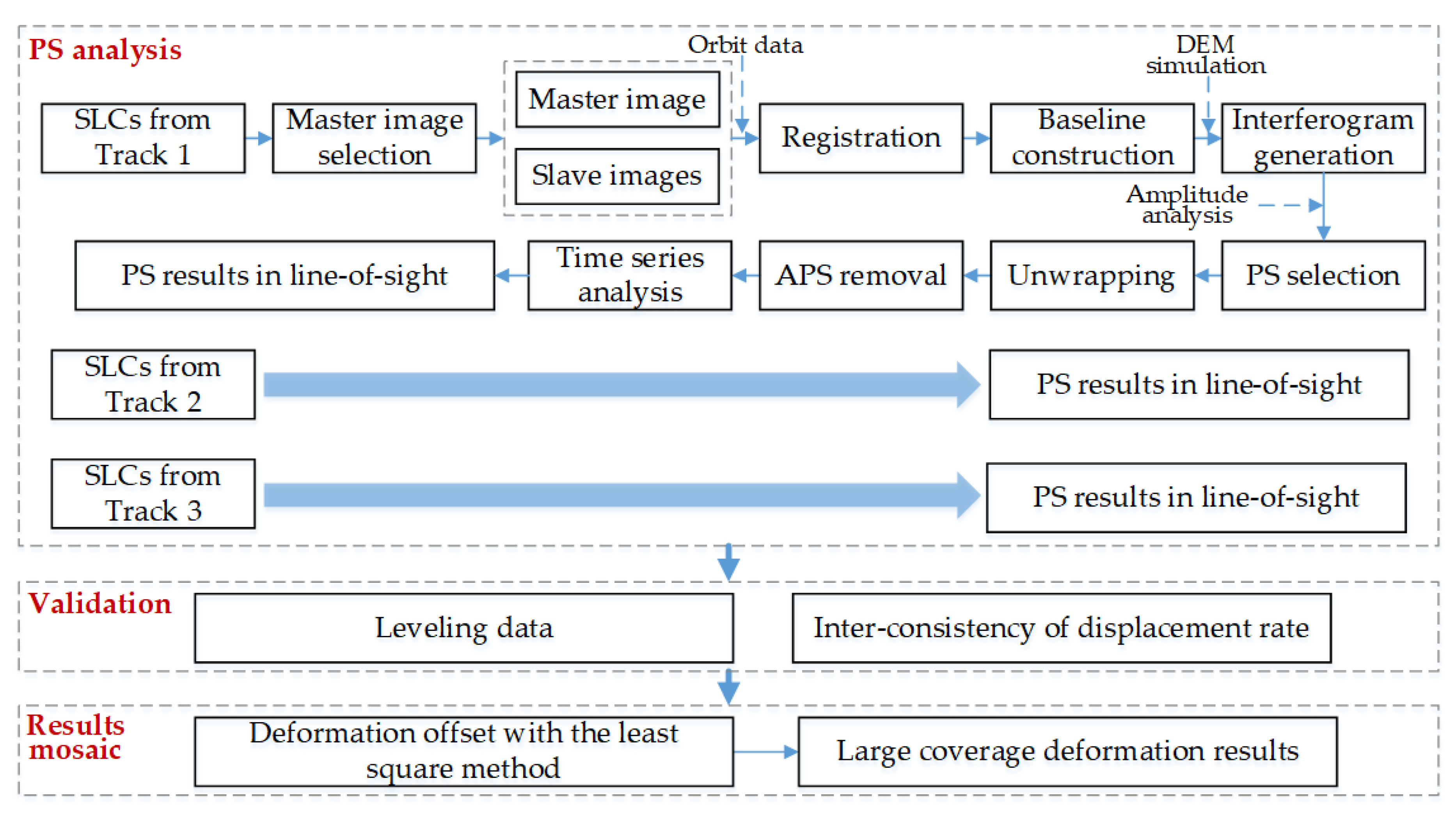
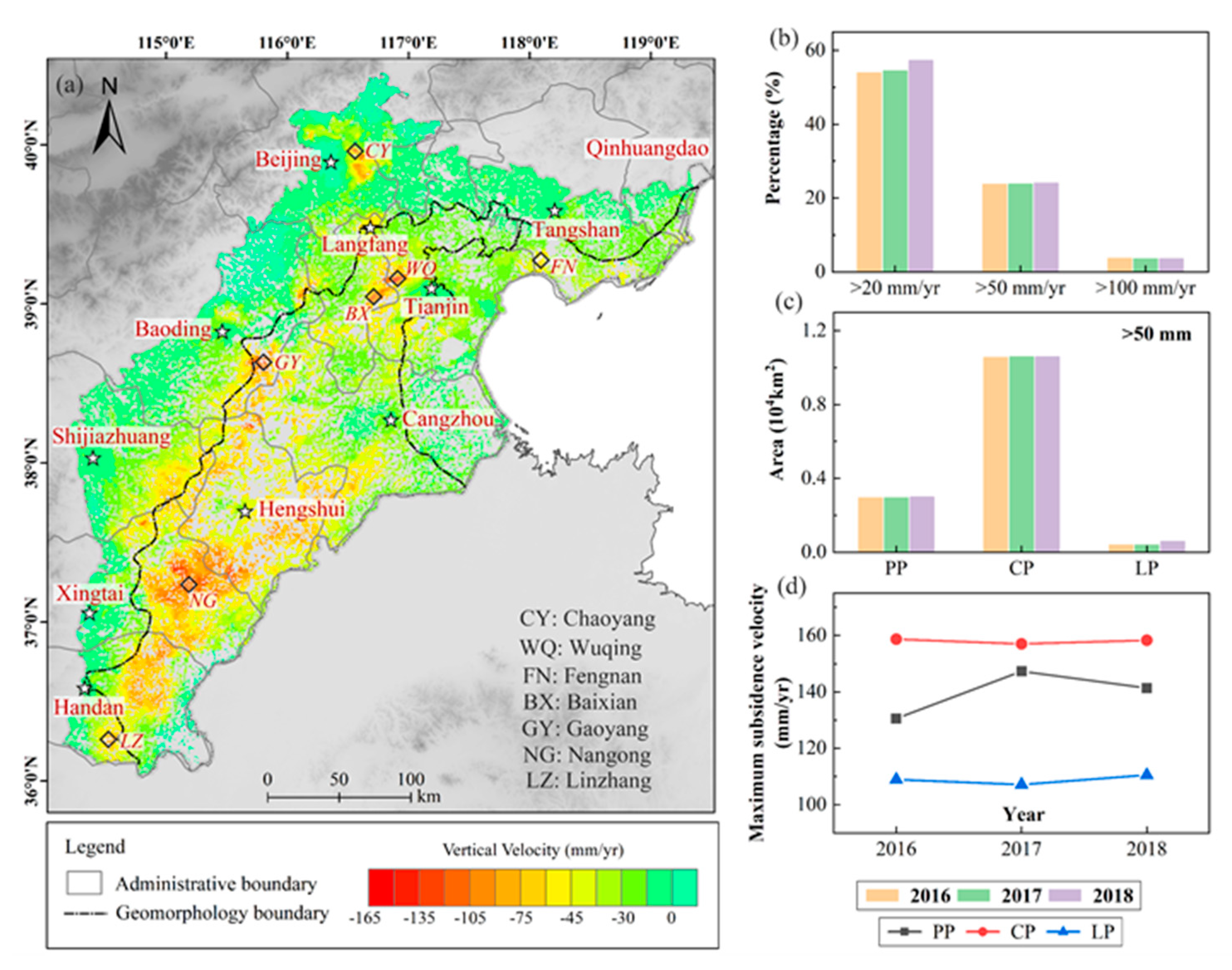
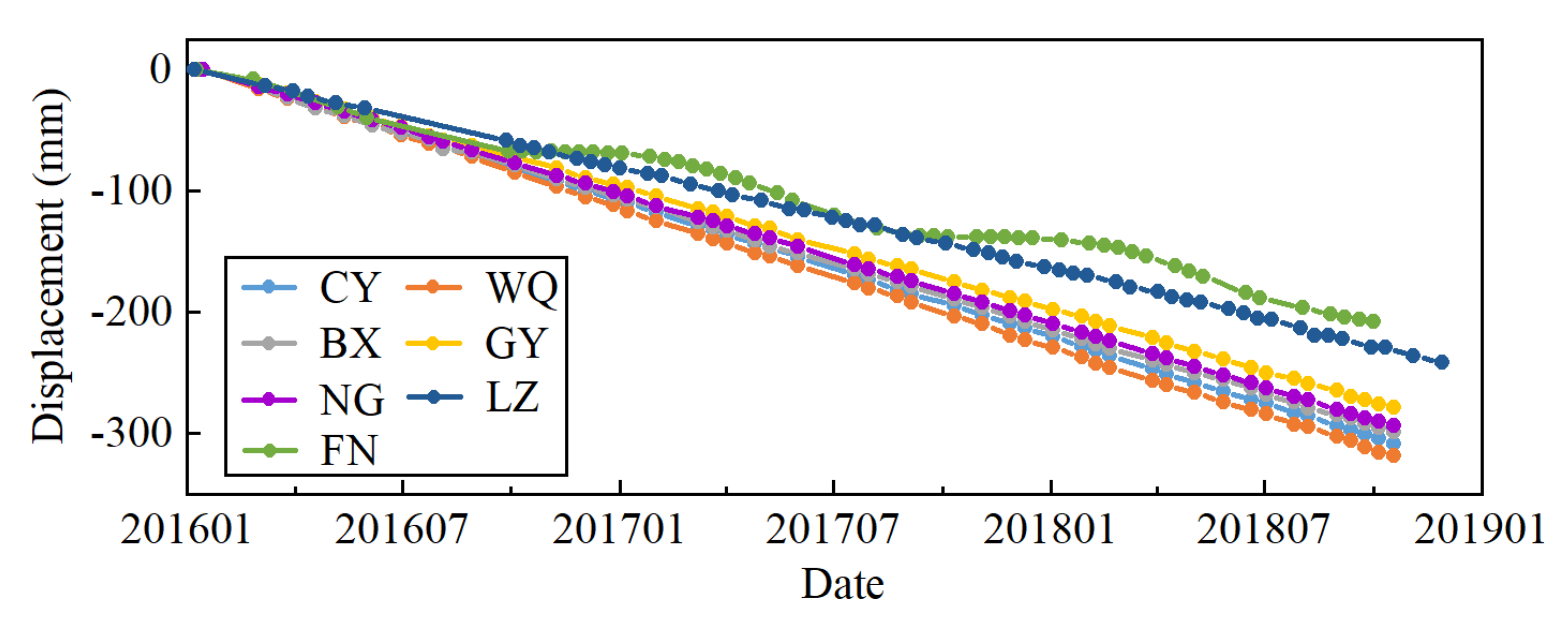
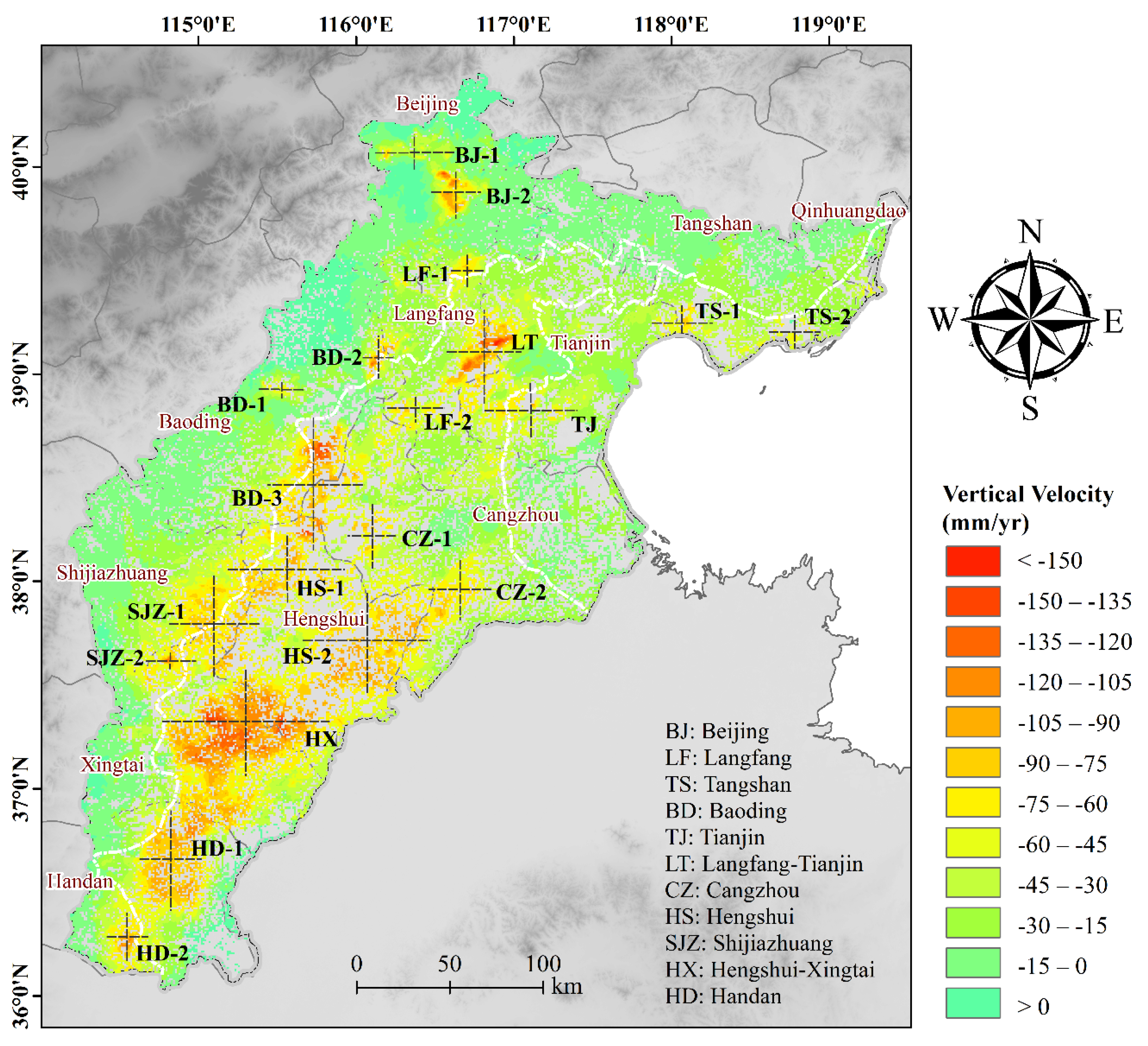
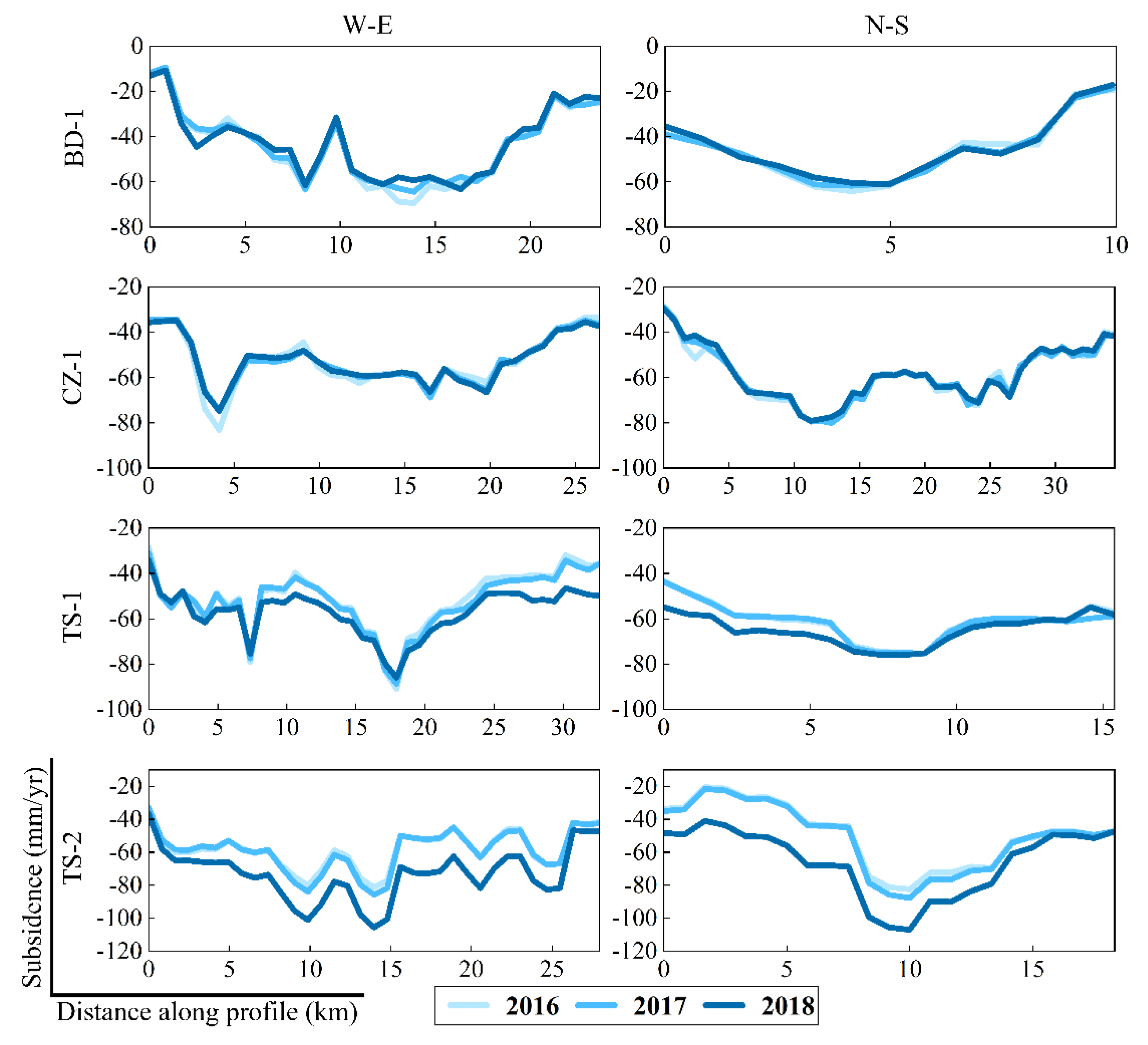

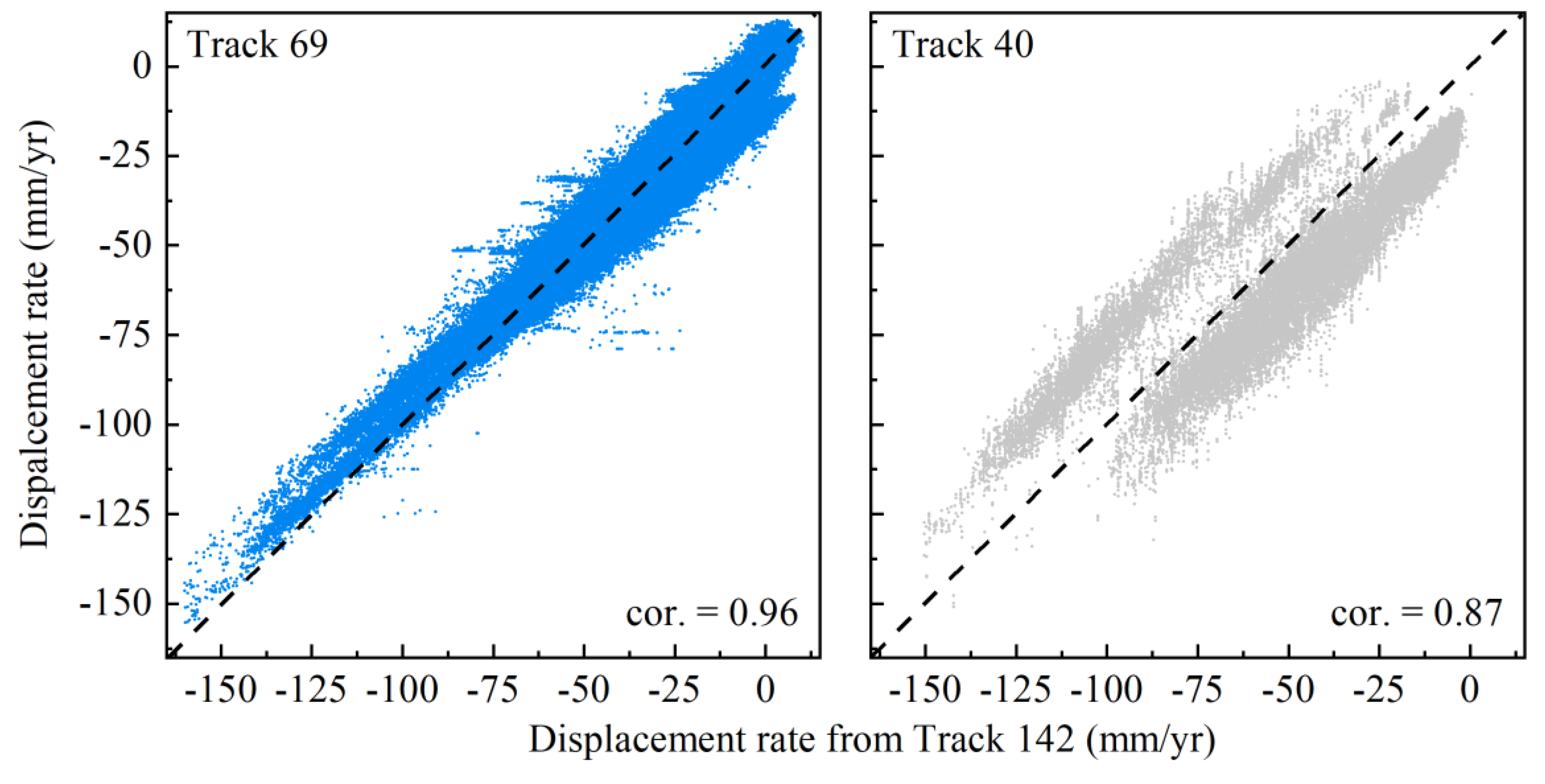
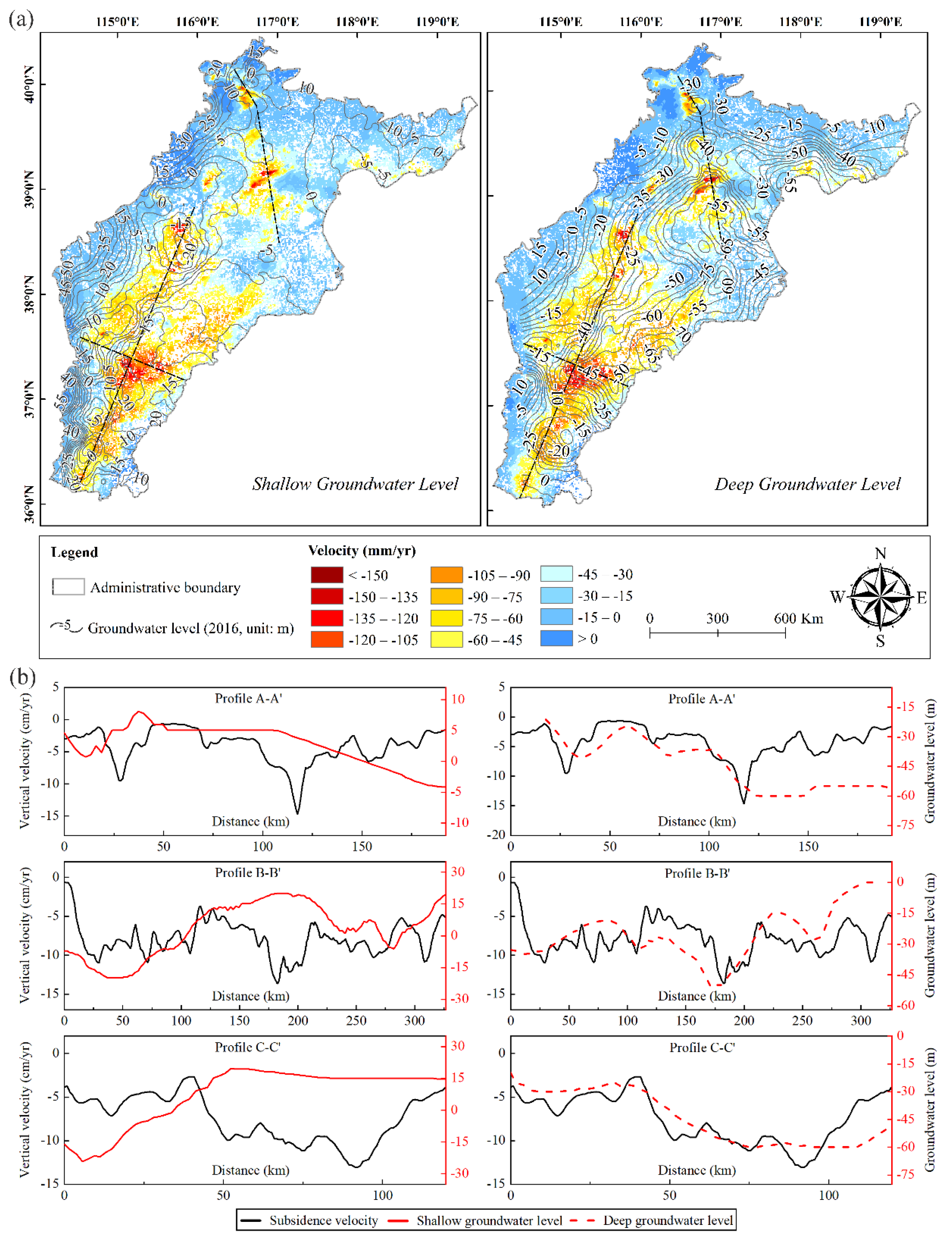
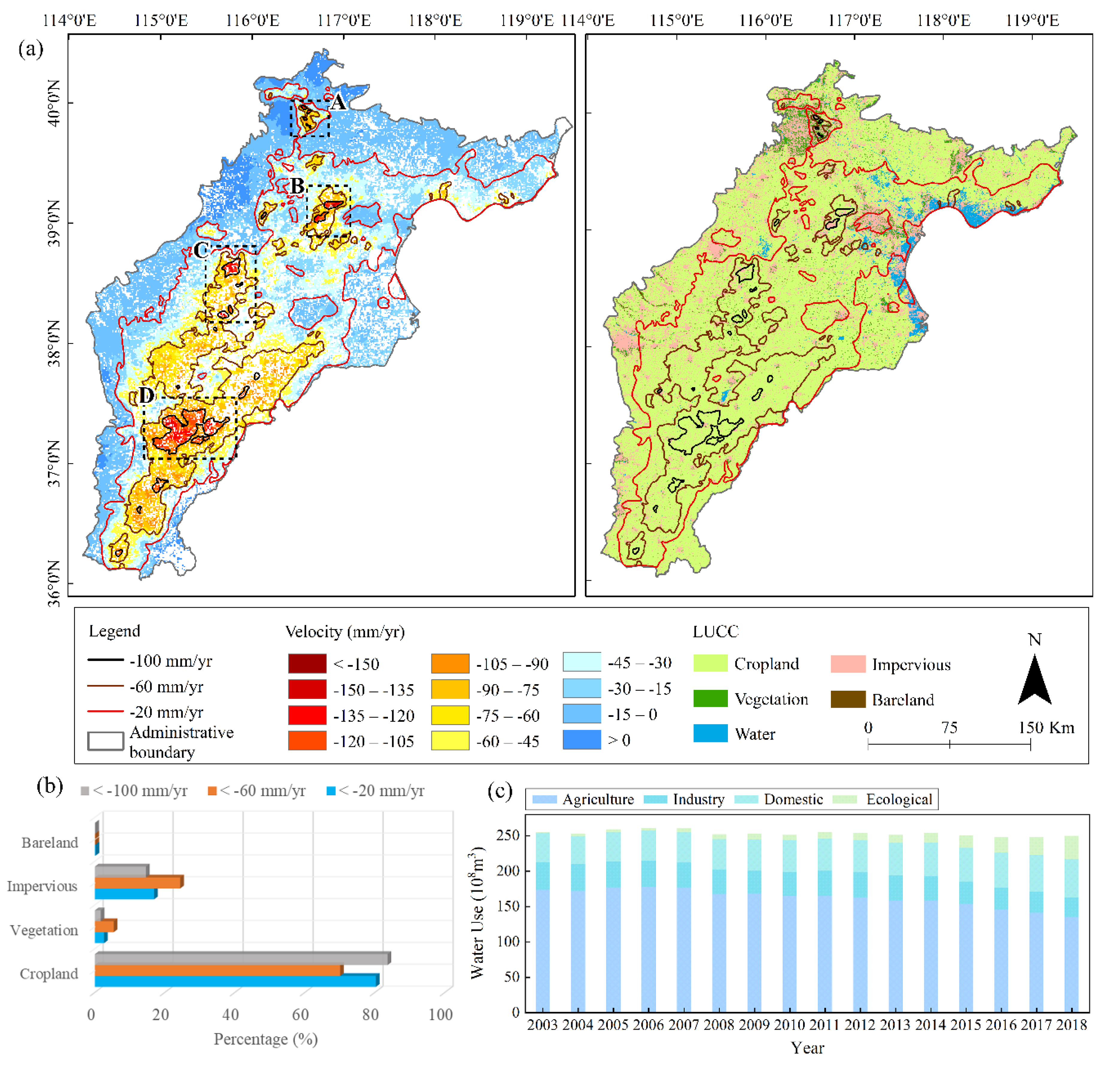
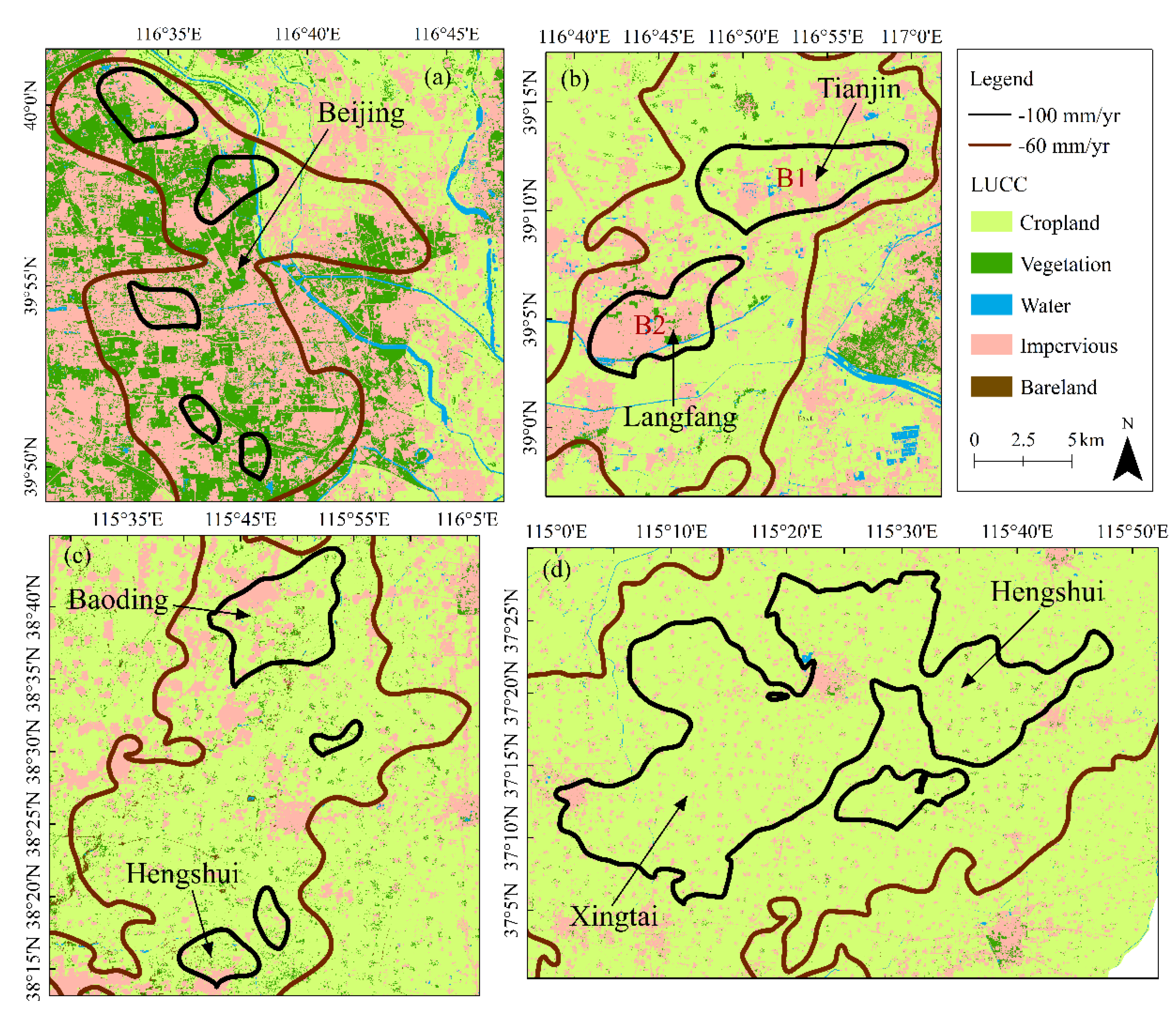
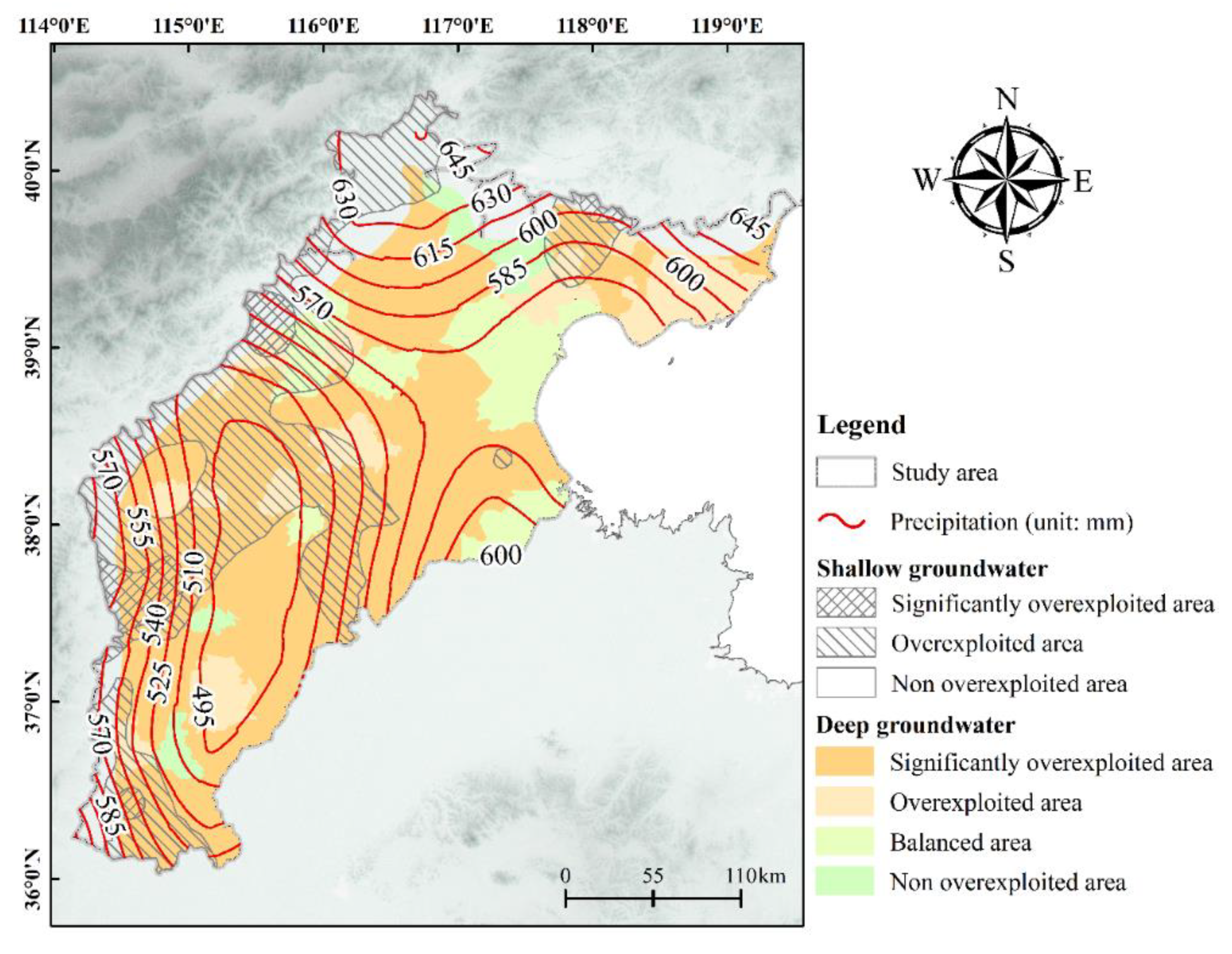
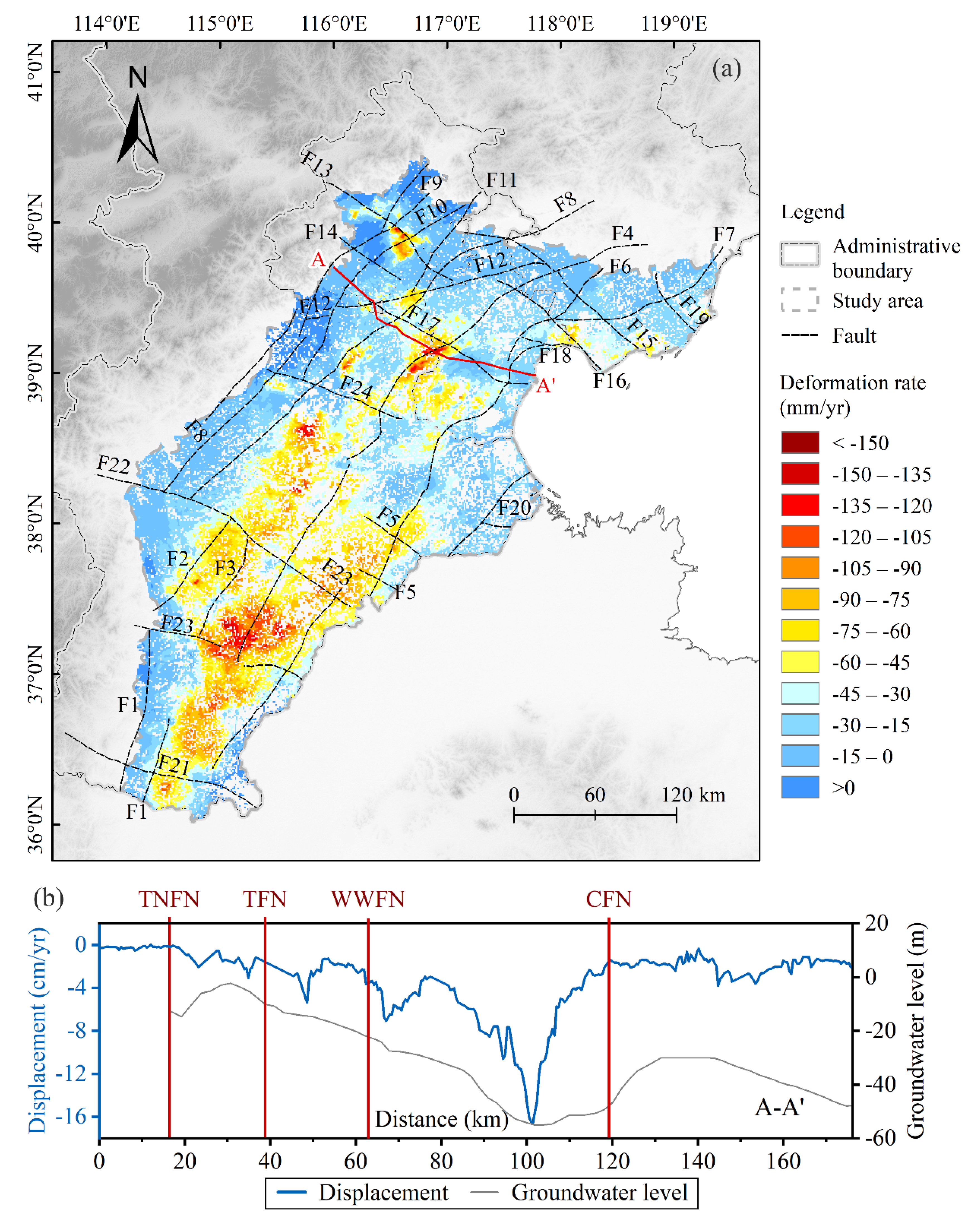
| Classification | Underground Water Type | Depth (m) | Quaternary |
|---|---|---|---|
| Aquifer 1 | unconfined | 10–50 | the Holocene formation (Q4) |
| Aquifer 2 | shallow confined | 120–210 | the upper Pleistocene formation (Q3) |
| Aquifer 3 | confined | 250–310 | the middle Pleistocene formation (Q2) |
| Aquifer 4 | confined | 350–550 | the lower Pleistocene formation (Q1) |
| Satellite | Track No. | No. of Images | Date Rang | Orbit Direction | Polarization | Image Mode |
|---|---|---|---|---|---|---|
| Sentinel-1A | 40 | 165 | 7 January 2016–28 November 2018 | Ascending | VV | Interferometric wide swath |
| 142 | 141 | 14 January 2016–18 October 2018 | ||||
| 69 | 98 | 9 January 2016–1 October 2018 |
| Zone List | Area (km2) | Major Land Use (%) | |||
|---|---|---|---|---|---|
| Cropland | Impervious Land | Vegetation | Bare Land | ||
| A | 30.76 | 6.61 | 59.75 | 33.57 | 0.07 |
| B | 145.77 | 50.58 | 46.41 | 2.87 | 0.05 |
| C | 1233.94 | 89.87 | 9.52 | 0.6 | 0.02 |
| D | 244.31 | 75.23 | 20.53 | 3.49 | 0.75 |
| B1 | 61.89 | 26.87 | 66.92 | 6.15 | 0.06 |
| B2 | 83.87 | 68.08 | 31.27 | 0.61 | 0.04 |
| No. | Name | No. | Name |
|---|---|---|---|
| F1 | Taihang fault zone | F13 | Nankou–Sunhe fault zone |
| F2 | Shulu–Ningjin fault zone | F14 | Yongding river fault zone |
| F3 | Baichikou fault zone | F15 | Sanhe–Fengnan fault zone |
| F4 | Wuqing–Wenan fault zone | F16 | Jiyun river fault zone |
| F5 | Cangdong fault zone | F17 | Haihe fault zone |
| F6 | Tangshan–Ninghe fault zone | F18 | Hangu fault zone |
| F7 | Changli–Ninghe fault zone | F19 | Laoting fault zone |
| F8 | Eastern Taihang fault zone | F20 | Ningjin–Haixing fault zone |
| F9 | Huangzhuang–Gaoliying fault zone | F21 | Linzhang–Daming fault zone |
| F10 | Tongxian–Nanyuan fault zone | F22 | Hengshui–Dezhou fault zone |
| F11 | Xiadian–Mafang fault zone | F23 | Neiqiu–Qinghe fault zone |
| F12 | Zhuozhou–Baodi fault zone | F24 | Xushui–Dacheng fault zone |
Publisher’s Note: MDPI stays neutral with regard to jurisdictional claims in published maps and institutional affiliations. |
© 2020 by the authors. Licensee MDPI, Basel, Switzerland. This article is an open access article distributed under the terms and conditions of the Creative Commons Attribution (CC BY) license (http://creativecommons.org/licenses/by/4.0/).
Share and Cite
Shi, M.; Gong, H.; Gao, M.; Chen, B.; Zhang, S.; Zhou, C. Recent Ground Subsidence in the North China Plain, China, Revealed by Sentinel-1A Datasets. Remote Sens. 2020, 12, 3579. https://doi.org/10.3390/rs12213579
Shi M, Gong H, Gao M, Chen B, Zhang S, Zhou C. Recent Ground Subsidence in the North China Plain, China, Revealed by Sentinel-1A Datasets. Remote Sensing. 2020; 12(21):3579. https://doi.org/10.3390/rs12213579
Chicago/Turabian StyleShi, Min, Huili Gong, Mingliang Gao, Beibei Chen, Shunkang Zhang, and Chaofan Zhou. 2020. "Recent Ground Subsidence in the North China Plain, China, Revealed by Sentinel-1A Datasets" Remote Sensing 12, no. 21: 3579. https://doi.org/10.3390/rs12213579
APA StyleShi, M., Gong, H., Gao, M., Chen, B., Zhang, S., & Zhou, C. (2020). Recent Ground Subsidence in the North China Plain, China, Revealed by Sentinel-1A Datasets. Remote Sensing, 12(21), 3579. https://doi.org/10.3390/rs12213579






